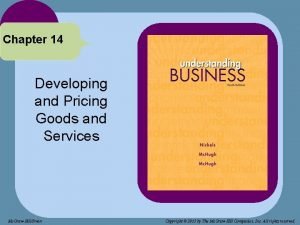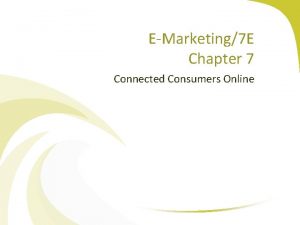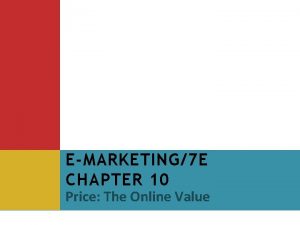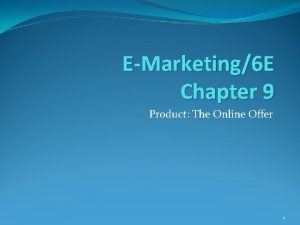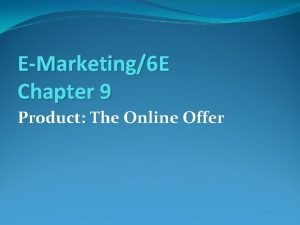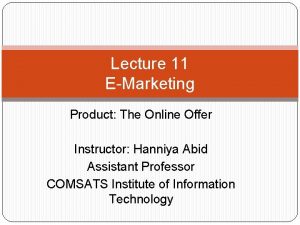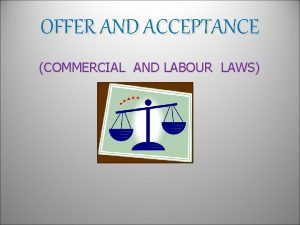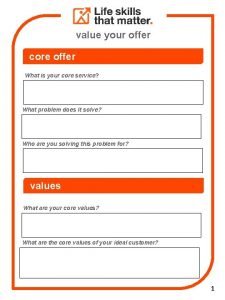EMarketing7 E Chapter 9 Product The Online Offer


























- Slides: 26

E-Marketing/7 E Chapter 9 Product: The Online Offer

Chapter 9 Objectives • After reading Chapter 9, you will be able to: – Define product and describe how it contributes to customer value. – Discuss how attributes, branding, support services, and labeling apply to online products. – Outline some of the key factors in emarketing enhanced product development. © 2014 Pearson Education, Inc. publishing as Prentice Hall 9 -2

The Google Story • In 1998, co-founders Brin and Page delivered an innovative new search strategy that ranked results on popularity as well as keywords. • Today, Google performs over a billion searches a day in 181 countries, speaks 146 languages and is the most-visited U. S. Web site. • Had revenues of $37. 9 B and 25. 7% in net income in 2011 and continues to grow in sales, new markets, and new products offered. © 2014 Pearson Education, Inc. publishing as Prentice Hall 9 -3

The Google Story, cont. • Uses a media e-business model to generate revenue, 96% of its revenues from advertising. • Google’s product mix includes 24 search products, 3 advertising products, 20 applications, and many enterprise products. • Pays close attention to user value, keeps costs low, and delivers eyeballs to advertisers. • What types of products do you think Google will launch next? © 2014 Pearson Education, Inc. publishing as Prentice Hall 9 -4

Many Products Capitalize On Internet Properties • A product is a bundle of benefits that satisfies needs of organizations or consumers. – Includes goods, services, ideas, people, and places. – Products such as search engines are unique to the internet while others simply use the internet as a new distribution channel. • Organizations use research to determine what is important to customers when creating new products. • The marketing mix 4 Ps and CRM work together to produce relational and transactional outcomes with consumers. © 2014 Pearson Education, Inc. publishing as Prentice Hall 9 -5

Marketing Mix & CRM Strategies & Tactics © 2014 Pearson Education, Inc. publishing as Prentice Hall 9 -6

Creating Customer Value Online • Customer Value = Benefits - Costs • Product decisions must be made that deliver benefits to customers. – Attributes – Branding – Support Services – Labeling – Packaging © 2014 Pearson Education, Inc. publishing as Prentice Hall 9 -7

Product Benefits: Attributes • Attributes include quality and specific features. - with quality, customers know 'you get what you pay for'. Higher quality means higher prices. - product features include such elements as color, style, size and online speed of service • Benefits are the same features from a user perspective. © 2014 Pearson Education, Inc. publishing as Prentice Hall 9 -8

Product Benefits: Attributes (contd. ) • The internet increases customer benefits in ways that have revolutionized marketing. – Media, music, software, and other digital products can be presented on the Web. – Mass customization is possible. – User personalization of the shopping experience can be achieved. © 2014 Pearson Education, Inc. publishing as Prentice Hall 9

Product Benefits: Branding • A brand includes a name, symbol, or other identifying information. – When a firm registers the information with the U. S. Patent Office, it becomes a trademark and is legally protected. • A brand represents a promise or value proposition to its customers. – Delivering on this promise builds trust, lowers risk, and helps customers by reducing stress of making product switching decisions. © 2014 Pearson Education, Inc. publishing as Prentice Hall 9 -10

Brand Equity • Brand equity is the intangible value of a brand, measured in dollars. • A great brand taps into popular culture and touches consumers. • Exhibit 9. 3 displays rankings for some of the top brands. © 2014 Pearson Education, Inc. publishing as Prentice Hall 9 -11

Highest Value Global Brands © 2014 Pearson Education, Inc. publishing as Prentice Hall 9 -12

A Great Brand Intersects with Popular Culture and Touches Consumers © 2014 Pearson Education, Inc. publishing as Prentice Hall 9 -13

Brand Relationships and Social Media • Ernst & Young found that 63% of entertainment and media CEOs used social media to build brands. • Forrester Research identified 3 roles for social media in branding: – Build trust through social media relationships with consumers – Differentiate the brand in social media to enhance emotional connections – Nurture consumers in social media to build brand loyalty. ﺗﻐﺬﻳﺔ © 2014 Pearson Education, Inc. publishing as Prentice Hall 9 -14

5 Levels of Brand Relationship Intensity (Duncan 2002) © 2014 Pearson Education, Inc. publishing as Prentice Hall 9 -15

Branding Decisions for Web Products • Firms can use existing brand names or create new brands on the internet. • Some firms may use different names offline and online to avoid risk if the new product or channel should fail. – Sports Illustrated created thriveonline. com. – Wired originally changed its online version name to Hotwired. © 2014 Pearson Education, Inc. publishing as Prentice Hall 9 -16

Creating New Brands for Internet Marketing • Good brand names should: – Suggest something about the product. – Differentiate the product from competitors. – Be suitable for legal protection. • On the internet, a good brand name should be short, memorable, easy to spell, and translate well into other languages. © 2014 Pearson Education, Inc. publishing as Prentice Hall 9 -17

Co-Branding • Co-branding occurs when two companies form an alliance and put their brand names on a product: – Sports Illustrated co-brands with CNN as CNNSI. – Yahoo! Has joined with TV Guide and Gist to provide TV listings. – Earth. Link joined with Sprint in 1998 to provide ISP services. © 2014 Pearson Education, Inc. publishing as Prentice Hall 9 -18

Product Benefits: Support Services • Customer support is a critical component in the value proposition. • Customer service reps help customers with installation, maintenance, product guarantees, service warranties, etc. to increase customer satisfaction. • Comp. USA combines online and offline channels to increase customer support. © 2014 Pearson Education, Inc. publishing as Prentice Hall 9 -19

Product Benefits: Labeling • Labeling has digital equivalents in the online world. – Online labels provide information about product usage and features. – Online labels also provide extensive legal information about the software product. • Online firms may add the Better Business Bureau logo or TRUSTe privacy shield. • Many sites present social media logos as labels on their pages. These logos add to the credibility and technology competence of the company. © 2014 Pearson Education, Inc. publishing as Prentice Hall 9 -20

FTC’s “Label” Page Discusses Its Privacy Policy © 2014 Pearson Education, Inc. publishing as Prentice Hall 9 -21

Customer Codesign via Crowdsourcing • Internet technology allows collaboration to occur electronically among consumers and across international borders. • Software developers often seek customer input about new products. – They often allow users to download beta version products, test them, and provide feedback. • Good marketers look for customer feedback to improve products. – Some set up sites to gather customer ideas and input: mystarbucksidea. com. © 2014 Pearson Education, Inc. publishing as Prentice Hall 9 -22

New-Product Strategies for E-Marketing • • • Many new products, such as You. Tube, Yahoo!, and Twitter, were introduced by “one-pony” firms built around the company’s first successful product. Other firms have added internet products to an already successful product mix. Product mix strategies can help marketers integrate offline and online strategies. © 2014 Pearson Education, Inc. publishing as Prentice Hall 9 -23

Product Mix Strategies • Firms will select one or more of the following strategies, based on marketing objectives, risk tolerance, resource availability, etc. – Discontinuous innovations are new-tothe-world products. – New-product lines are new products in a different category for an existing brand name. – Additions to existing product lines. © 2014 Pearson Education, Inc. publishing as Prentice Hall 9 -24

Product Mix Strategies, cont. • • • Improvements or revisions of existing products. Repositioned products can be targeted to different markets or promoted for new uses. Me-too lower-cost products. © 2014 Pearson Education, Inc. publishing as Prentice Hall 9 -25

All rights reserved. No part of this publication may be reproduced, stored in a retrieval system, or transmitted, in any form or by any means, electronic, mechanical, photocopying, recording, or otherwise, without the prior written permission of the publisher. Printed in the United States of America. Copyright © 2014 Pearson Education, Inc. Publishing as Prentice Hall 9 -26
 Early offer sip
Early offer sip Total product offer
Total product offer Hát kết hợp bộ gõ cơ thể
Hát kết hợp bộ gõ cơ thể Slidetodoc
Slidetodoc Bổ thể
Bổ thể Tỉ lệ cơ thể trẻ em
Tỉ lệ cơ thể trẻ em Chó sói
Chó sói Chụp phim tư thế worms-breton
Chụp phim tư thế worms-breton Alleluia hat len nguoi oi
Alleluia hat len nguoi oi Các môn thể thao bắt đầu bằng tiếng bóng
Các môn thể thao bắt đầu bằng tiếng bóng Thế nào là hệ số cao nhất
Thế nào là hệ số cao nhất Các châu lục và đại dương trên thế giới
Các châu lục và đại dương trên thế giới Công của trọng lực
Công của trọng lực Trời xanh đây là của chúng ta thể thơ
Trời xanh đây là của chúng ta thể thơ Cách giải mật thư tọa độ
Cách giải mật thư tọa độ 101012 bằng
101012 bằng Phản ứng thế ankan
Phản ứng thế ankan Các châu lục và đại dương trên thế giới
Các châu lục và đại dương trên thế giới Thể thơ truyền thống
Thể thơ truyền thống Quá trình desamine hóa có thể tạo ra
Quá trình desamine hóa có thể tạo ra Một số thể thơ truyền thống
Một số thể thơ truyền thống Cái miệng nó xinh thế
Cái miệng nó xinh thế Vẽ hình chiếu vuông góc của vật thể sau
Vẽ hình chiếu vuông góc của vật thể sau Nguyên nhân của sự mỏi cơ sinh 8
Nguyên nhân của sự mỏi cơ sinh 8 đặc điểm cơ thể của người tối cổ
đặc điểm cơ thể của người tối cổ Giọng cùng tên là
Giọng cùng tên là Vẽ hình chiếu đứng bằng cạnh của vật thể
Vẽ hình chiếu đứng bằng cạnh của vật thể

